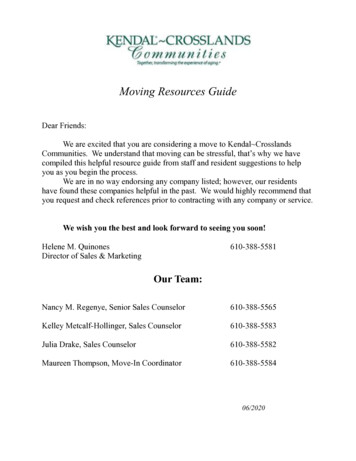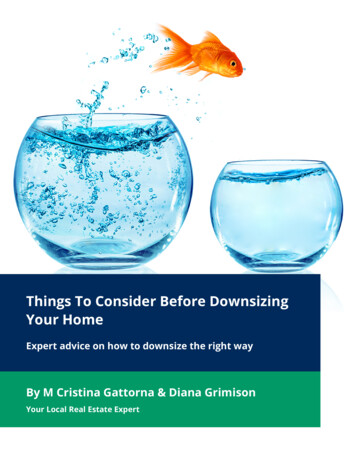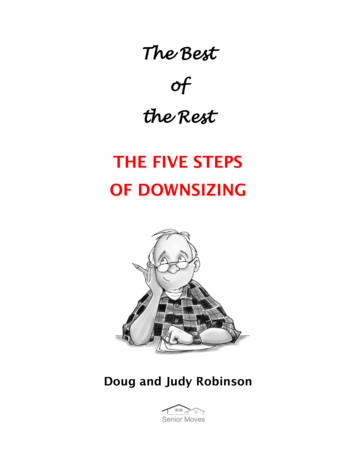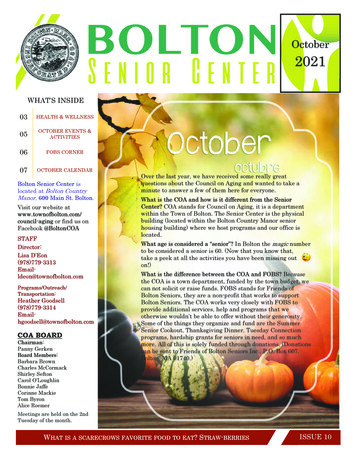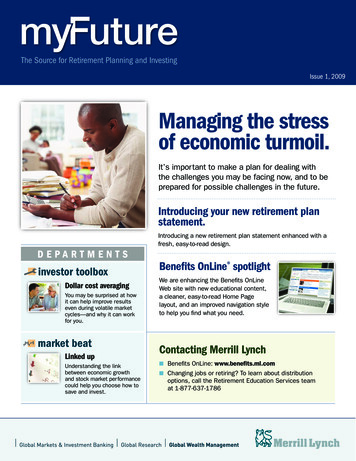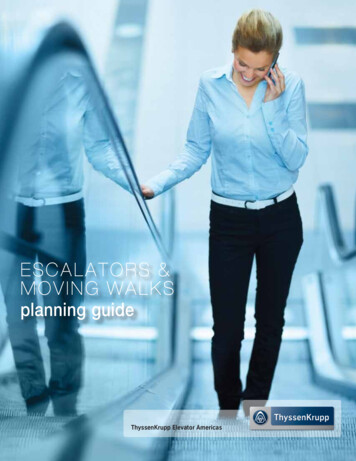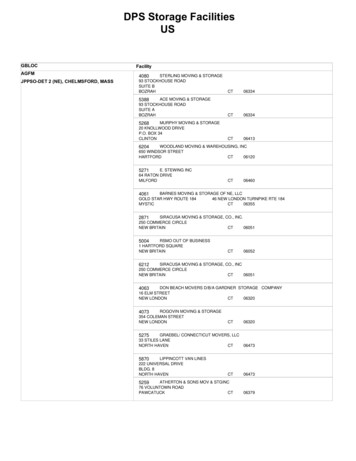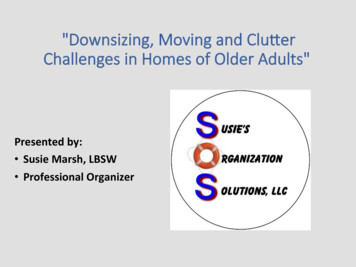
Transcription
"Downsizing, Moving and Clu4erChallenges in Homes of Older Adults"Presented by: Susie Marsh, LBSW Professional Organizer
10 Ques?ons to Consider when thinking of Downsizing/De-cluGering/GeIng Organized:1. Do you want to have a simplified life?2. Are you ready to let go and de-clu erand/or downsize your current home?3. Are you in a life transiBon such as,moving to a senior community, to arelaBve’s home or to a smaller home?4. Are your personal relaBonshipsaffected because there is too muchclu er in your home?5. Are you struggling with "brain clu er'"?
10 Ques?ons Con?nued 6. Can you find your importantdocuments easily? (banking,budget/bills, insurance, etc.)7. Are you rebuying items (wasBngmoney) because you can’t find theitems you were looking for?8. Are you constantly looking for lost ormisplaced items?9. Do you feel depressed or anxiousthinking about all the clu er andchaos around you?10. Is it harder for you to keep your houseorganized and clu er free because ofphysical or mental limitaBons?
Downsizing To-Do’s: Start early! If you are thinking of moving, start theprocess to downsize your possessions 12-18months prior to the move. Talk to your family/friends about your wishes todownsize. Think about giving items to family/friends now soYOU can enjoy them enjoying the items. Moving? Think about how much space you willhave in your new home or newly organized spaces.Measure and map out a floor plan. Ask yourself, "Does this item have a “Purpose andPlace” in my home? How can I uBlize all of my available and valuablespaces in my home? (ie. behind doors, insidecabinet doors, under beds, wall spaces, etc.) Don’t let guilt dictate what items you keep.
How to Get Started with De-CluGering:Sor?ng Process:(set up bins/boxes to sort into and label them): Donate Give to family/friends Keep Toss/Recycle Relocate in the homeATer Sor?ng Process is Completed: Put donate items into your vehicle to deliver to yourcharity of choice.Put items in their places that are in the “Relocate” box.Put items to give to friends/family by your front door orin your vehicle so you remember to distribute them. Useholidays as a Bme to give heirlooms/treasures to familymembers or friends.Take out the trash and recycle to the waste area rightaway.
Treasures or Trash?
Op?ons to Reduce your CluGer:1. Garage Sales- you get all of the profits but are alot of labor to run for Medium to Low return2. Estate Sales- good opBon if you have a lot ofitems or have items worth more than garage salevalue; % paid to estate sale company; onlineestate sales are an opBon too3. Auc?on- good opBon if you have large items/valuable items; % paid to aucBon company4. Dona?on- good opBon if you want to moveitems out fast and use as a tax deducBon (ifapplicable)5. Consignment- good opBon if you have in style orhigh value clothing and goods; good opBon forfurniture too; % paid to consignment shop6. Online- good opBon to get the most money foryour items, however, the process to sell can takea lot of Bme, there can be safety concerns,shipping cost and need to be tech savy
Manage the Paperwork Flow: Moving? Do a temporary addresschange with the USPS andextend it aner 6 months. Do Not do a permanentaddress change or you willget spammed by 500 companies! Set up a Paperwork Command Center withthe following: Master Calendar To-Do lists, etc. ACTION items (ie. Bills to pay,papers to fill out, etc.)Inbox/Outbox flow: AcBon/To Be Filed/Toss/Recycle/ShredEffecBve Filing System: File it, Don’t pile it. Set up a system you will useAre you tech savy? Use technology tosimplify how you pay bills, make lists, makeappointments, etc.Get off the Junk Mail Lists/Paper Recycling: reen.comwww.papergatorrecycling.com
Chronic Disorganiza?on: What is it?Chronic DisorganizaBon is found at the extreme end of the conBnuum,differing from severely disorganized. Chronic disorganizaBon is marked byits longevity, interference with quality of life and resistance to self-helpefforts. " Reference: ICD Fact Sheet-001Chronic DisorganizaBon challenges can stem from condiBons such as,anxiety, depression, hoarding, chronic illness, traumaBc brain injury, ADD,PTSD and more.Situa?onal Disorganiza?on: What is it?DisorganizaBon that is caused by circumstances in a person's life thatis not an ongoing situaBon.Examples: Medical condiBon (acute) Change in family situaBon (ie. Birth, death, job loss, divorce, etc.) Moving Lack of Bme (ie. Work, Family obligaBons, etc.) Spaces are inadequate (ie. Small home, lack of storage, etc.)
Why is Excessive Clu4er a Problem? 1. Safety Hazard Fall risk with pathways/mazes/piles. Risk of items falling on homeowner. Risk of fire (i.e. Items too close to fire hazards and/or daisychaining of cords.) Dangerous to first responders (i.e. EMS, Fire, Police, etc.)2. Public Health Hazard InfestaBons that spread (i.e. Fleas, cockroaches, bedbugs, etc.) Unsanitary- human or animal waste; lack of working toilets/water/sewage system Yard/Home Disrepair/Standing water mosquitos (Lymedisease),Bcks; trash a racts vermin3. Health Hazard Respiratory issues/infecBon risk- black mold, animal urine/feces,bug bites, food poisoning, etc.
CollecBng vs. HoardingCollec?ng behaviors : Usually involves display of items for show Sense of pride for the items collected Specific locaBons in home to house collecBon Budgets and saves money to acquire new items in collecBon andfeels a sense of saBsfacBon when adding them to the collecBon Items are usually organized and well maintainedHoarding behaviors: Feel embarrassment by their possessions or "mess" (won't letothers in their home) Lack of funcBonal organizaBon of possessions Loss of funcBonal living space due to clu er Onen have debt, someBmes extreme due to conBnual purchasingof items Sees potenBal or use in items no ma er if the item is of li le value,broken, etc. Strained relaBonships over the amount of clu er
What is Hoarding Behavior?DSM-5 (American Psychiatric AssociaBon, 2013) states that Hoarding Disorder is present when thefollowing criteria are met:o Persistent difficulty discarding or parBng with possessions, regardless of their actual value.o This difficulty is due to a perceived need to save the items and distress associated with discardingthem.o The symptoms result in the accumulaBon of possessions that congest and clu er acBve living areasand substanBally compromise their intended use.o The hoarding causes clinically significant distress or impairment in social, occupaBons, or otherimportant areas of funcBoning.o The hoarding symptoms are not due to a general medical condiBon.o The hoarding symptoms are not restricted to the symptoms of another mental disorder. (E.g.hoardingdue to obsessions in Obsessive-Compulsive Disorder, lack of moBvaBon in Major Depressive Disorder,delusions in Schizophrenia or another PsychoBc Disorder, cogniBve deficits in DemenBa, restrictedinterests in AuBsBc Disorder, food storing in Prader-Willi Syndrome)The DSM also lists two "specifiers" (features that may or may not be present):o Excessive acquiringo Poor insight
Why do People Hoard?q TraumaBc life experience (i.e. Abuse, death, divorce,evicBon, loss of possessions, etc.)q SenBmental value.q Recessive trait (traumaBc life experience would bring it tothe forefront).q Holding onto items make them feel safer and happier.q Feelings of responsibility for items.q Fear of losing things. Memory issues.q Indecisiveness.q PerfecBonism. Fear of "doing it wrong" or makingmistakes.q Sees usefulness and potenBal in every item.q Growing up in an environment of hoarding.q Can progressively get worse with age.q Stronger a achment to things than to people aroundthem.q OrganizaBonal problems- (i.e. ADD) execuBve funcBoningdeficits.
Tools for Assessment:§ Clu er-Hoarding Scale- 5 levels(InsBtute for Challenging DisorganizaBon)www.challengingdisorganizaBon.org§ Clu er Image RaBng Scale- 9 levels(www.oxfordclinicalpsych.com) App available§ Clu er Self-Assessment - 16 quesBonsAssessments aim to idenBfy: health & safety issues/hazardous items,severity of hoard, household funcBoning, infestaBons, accessibility ofthe home, personal protecBve equipment requirement, client's insightand desire for change
Who sees Hoarding behavior?o Property Management company workers, landlords, etc.o Neighborso Home Health or Home Care Agencies (PT, OT , RN, Meals on Wheels, Aides, etc. )o Adult ProtecBve Services workers, Social Workers,o First Responders (i.e. Fire and Police, EMS, etc. )o Repairmen (ie. Appliances, cable/internet/phone, etc.)o Gas or electric companyo Delivery peopleo Others? .The person hoarding usually is resistant to intervenBon and isn't the one calling for help.It is usually the family/friends or someone else.
What does Hoarding look like?
How to Help with Hoarding?Hoarding is a serious issue that onen requires professional intervenBon. Here aresome guidelines to follow if you are working with someone who hoards:Do: Be PaBent and Understanding. Know your own limitaBons. Ask open ended quesBons to find out more/Hear their story. Treat the person with dignity and respect/build trust. Evaluate for health safety. Focus on harmreducBon. Refer for medical and/or mental healthservices . Recognize it is a behavior that will be difficultto change as it has brought him/her comfortin the past. Be a cheerleader!!! Set up for success. Work in one area at aBme/set small targeted goals for inspecBon.Main living area first. Slow steady progress in the goal. Advocate for more funding to help pay forresources. Be specific about expectaBons for each area that needsintervenBon. (Wri en goals, Vision boards, color codedreminders) Help maintain focus on the tasks at hand. (i.e. Use ofBmers, Bme management schedules, etc.). Get permission to speak to family/friends involved. Involve the person in seeking soluBons. Provide resources for ongoing hands on assistance. (ie.professional organizer, volunteers, etc.) Stop new items from being brought into the home. (i.e.contract of compliance, etc. ) Be prepared for relapse. Changing habits/behaviors takesBme and moBvaBon. Reduce incoming paper: www.dmachoice.org /www.paperkarma.com; m (local recycling atchurches/schools/nonprofits)
How to Help with Hoarding ? (Cont.)What NOT to do: Pass judgment/Be criBcal.Talk about the person as if he/she is not present.Argue with the person.Make decisions for the person/disregard theperson's input.Lie to the person.Remove any item without permission.Tell the person how they should feel.Expect that a rapid clean out will solve the problem.Go into the situaBon unprepared for safety and/orhealth hazards.
Hoarding Task Forces:Grand Rapids Area Hoarding Task Force: Headed up by City of GR Code Compliance supervisor and GRPDCommunity Liaison officer. MulBple agency involvement forassistance and educBon to the community. h eDivision/Pages/GRAHT.aspx§ Contact: hoarding@grcity.usKalamazoo Hoarding Task Force:§ www.kalamazoohoarding.orgWashtenaw Hoarding Task Force:§ Hoarding@hxwashtenaw.orgTraverse Bay Area Hoarding Task Force:§ Traversebayhoarding@gmail.com
Mental Health Resources:§ Www.ocfoundaBon.org(InternaBonal OCD FoundaBon)§ Www.network180.org(Community Mental Health inKent County)§ www.childrenoyoarders.com(InformaBon for families ofperson with hoarding issues)Assis?ng Older Adults: www.nasmm.org(Moving-Senior movemanagers) www.caregiverresource.net(Resource info. for caregiversof older adults) www.AAAWM.org(Area Agency on Aging West MI)Clean Up Help:§ www.wmichhoarding.com(BioOne of W.Michigan)§ www.servicemaster.com(Kalamazoo, Grand Rapids) www.hoardingpros.com(serving throughout Michigan)Organiza?on Help:§ www.napo.net(Nat.'l Assoc. of Professional Organizers)(Check for speciality/training in chronicdisorganizaBon)§ www.napomichigan.com(NAPO Michigan Chapter)(Check for speciality/training in chronicdisorganizaBon)§ www.challengingdisorganizaBon.org(InsBtute for Challenging DisorganizaBon)§ Clu er-Hoarding Scale
Hoarding Disorder Resources:o Tolin,D. Frost,R. & Steketee,G., (2014), Buried in Treasures:Help for CompulsiveAcquiring, Saving and Hoarding, New York, The Oxford University Press.o Steketee,G. & Frost, R. (2014), Treatment for Hoarding Disorder,2nd ediBon,Workbook, New York, The Oxford University Press.o The InsBtute for Challenging DisorganizaBon, Varness,Kate, ed. ; (2012) The ICDChallenging DisorganizaBon: For Professional Organizers, St.Louis, MO, InsBtute forChallenging DisorganizaBon.o BraBoBs,C., Schmalisch,C. & Steketee, G., (2011), The Hoarding Handbook: A Guidefor Human ServiceProfessionals,New York, The Oxford University Press.
Contact InformaQon: Susie Marsh, LBSW , Professional Organizer Member of: NAPO (Nat.’l Assoc. of Professional Organizers) NAPO Michigan Chapter Vice President InsBtute for Challenging DisorganizaBon- Level 1CerBficate of Study in Hoarding The Caregiver Resource Network Byron Center Chamber of zeU@gmail.com616-554-3175
QuesBons?
Downsizing To-Do’s: Start early! If you are thinking of moving, start the process to downsize your possessions 12-18 months prior to the move. Talk to your family/friends about your wishes to dow

